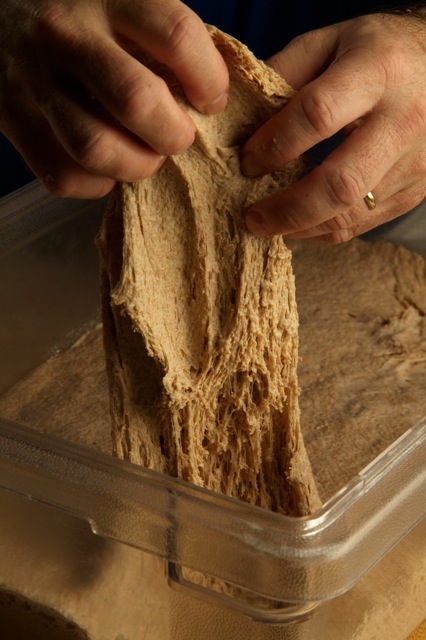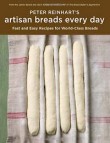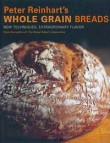The Stretch and Fold Method
 In some of the recipes that we’ve posted I refer to stretching and folding the dough, so I want to more fully explain it here, as I will continue to provide recipes that utilize this technique. The stretch and fold method (S&F from here on), is a remarkable way to maximize gluten development in a dough with minimum mixing time. It is sometimes referred to as “intermittent kneading” and also by the term “folding.” All of these refer to a similar method, though the time intervals may vary from recipe to recipe. In short, it means to intermittently fold the dough over onto itself during the fermentation stage. What this accomplishes is to strengthen the bonding of the gluten protein threads that hold the dough together and thus trap the carbon dioxide created by the yeast. This is what creates the bubbles or air pockets that we refer to as the “crumb” in the final bread.
In some of the recipes that we’ve posted I refer to stretching and folding the dough, so I want to more fully explain it here, as I will continue to provide recipes that utilize this technique. The stretch and fold method (S&F from here on), is a remarkable way to maximize gluten development in a dough with minimum mixing time. It is sometimes referred to as “intermittent kneading” and also by the term “folding.” All of these refer to a similar method, though the time intervals may vary from recipe to recipe. In short, it means to intermittently fold the dough over onto itself during the fermentation stage. What this accomplishes is to strengthen the bonding of the gluten protein threads that hold the dough together and thus trap the carbon dioxide created by the yeast. This is what creates the bubbles or air pockets that we refer to as the “crumb” in the final bread.
I suggest this technique more and more often in my classes and recipes, as it allows us to more fully hydrate the dough, almost to the point of over-stickiness, yet still create a very workable, dynamic dough, one that pops in the oven and creates more of the large irregular holes that artisan bakers (and consumers) love to see. The method is actually quite simple and I have short video that illustrates this at: http://www.youtube.com/watch?v=1timJlCT3PM .
To work with sticky dough many bakers use flour on the work surface and on their hand, but I prefer to use an oiled work surface (either olive or vegetable) and either oil my hands or dip them in water (sticky dough won’t stick to wet or oily hands). All you have to do is to transfer the dough from the mixer to the oiled work surface, pat it into a rectangle or ball, and then pull, or stretch out about half of the dough from one side and then flip the stretched piece back over the top of the dough, about to the middle. Then repeat this from the other three sides, stretching and folding half the dough back over the top of the dough. Then, when all four sides have been folded over, flip the whole dough ball over so that the smooth underside is face up and the folded top is underneath. At this point, you either place the dough into an oiled container or leave it on the oiled work surface and cover it with a bowl. (As I said, some bakers prefer to work with floured surfaces instead–that is totally up to you.)
You can repeat this S&F at 5, 10, or even 45 minute intervals, depending on your baking schedule for the dough in question. For same day bakes, three or four S&F’s at 30 to 40 minute intervals are common, which allows the dough to ferment in between the S&F’s. For overnight dough, such as pizza or focaccia or certain rustic bread formulas, the S&F intervals can be as short as 5 minutes. Typically, four S&F’s are sufficient to fully develop and firm up the dough, but some doughs require only one, while others might require five S&F’s if they are very wet.
This technique greatly enhances the oven spring and causes the dough to achieve a kind of bounce and liveliness that is hard to replicate by conventional mixing methods. It also allows us to push the envelope regarding hydration, sometimes making it possible to add as much as 5% to 10% more water than the recipe calls for. And most importantly, it’s also a lot of fun and gives great pleasure to watch and feel the dough get stronger and more vibrant with each S&F — yet another reminder that we’re working with a living, dynamic product.
Recent Articles by Peter Reinhart
- Peter Scott Ruben: Why Frank Sinatra is the true “Chairman of the Board,” and the Greatest of the Greats
- Elizabeth Brasch, Mellow Mushroom’s Has a Vision
- Nipun Sharma: Pizza’s A-I Robotics Future is Now
- Maui Pizza with Chef Jeff Scheer of Restaurant Marlow
- The Pizza Yodi’s Are Back –John Arena and Brian Spangler are in the House!
- Arthur Bovino and Alfred Schulz and Their Pizza Pod Party
Add Comment
You must be logged in to post a comment.










I recently started baking. My mom baked all the time so I thought I would do it as I like homemade bread over store bought sandwich bread.
I started with the basic Artisan “five minutes a day” that seems to be posted everywhere.
My first loaves (2 per 6.5 cups flour/3 cups water, salt, yeast) were a big flat. And the salt was too much, as it was Euro style. I cut back on the salt in the second time and it tasted better. The holes were close together, not a lot of big holes, but it was firm with chewy crust and it worked fine for sandwiches, although again, they were not very tall. The third time I put one future loaf into a thick ceramic pie plate (bowl? Not sure what to call it, shaped like a pie tin, but ceramic) and the other on an oiled cookie sheet. The one in the pie thingy formed up taller, and so was better for sandwich bread.
So I am wondering; should I S & F during the 2 hour rise? The recipe didn’t mention it, and I wonder if it will make my bread taller. 😉
[…] added to the blooming yeast as such. Through my research and experimentation I discovered the stretch and fold method for manipulating dough. Let your creativity shine when it comes to choosing your pizza […]